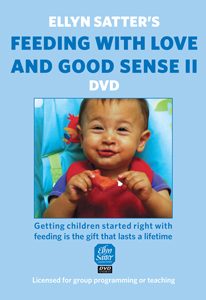

Family Meals Focus
The Ellyn Satter Institute Newsletter
Feeding in your baby’s first year
By Ellyn Satter, Registered Dietitian and Family Therapist
About the middle of your baby’s first year, you begin a weeks- to months-long transition from your child’s eating by breast or bottle to her finger-feeding herself soft family food at family meals. Knowing what you are doing during this transition period in feeding can make it easy, straightforward, and fun.
Keep in mind where you are going
As before, go by your baby’s cues and respect her temperament. Some children enthusiastically take to the spoon and, over a month or two, move from the first offer of semi-solid food through lumpy food to finger-feeding themselves soft family food. Others are slower to warm up and learn and need to be introduced gradually to a variety of semi-solid tastes and textures in a process that can take several months. Still others can’t be bothered with spoon feeding and only get the idea of eating solid foods when they are allowed to feed themselves with their fingers. A child who finger-feeds herself soft family food is what I call an almost-toddler. To start offering solid food and to progress through thicker, lumpier food to finger-fed soft family food, go by what your baby can do rather than how old she is. Provide her with mastery opportunities:1
- Observe when she is ready to learn.
- Know what she needs to learn.
- Give her opportunities to learn.
- Trust her to learn.
Your child’s attitude is most important of all
While the transition period in feeding can be easy and straightforward, for the unwary it is littered with pitfalls.
While the transition period in feeding can be easy and straightforward, for the unwary it is littered with pitfalls. To keep yourself serene though it all, remember:
- Most important of all is that your child feel positive and comfortable with food and the feeding process.
- A child who feels good about eating will eat what she needs and eat as much as she needs.
- Parents who get desperate about the introduction-to-solid-foods stage feel their child has to have solid foods (she doesn’t) and/or worry about how much to feed (their child knows).
- Parents’ desperation makes them pushy, and that spoils it all: the child’s attitudes about eating, her willingness to try new foods, her eating the amount she needs, and her growing in the way that is right for her.
Each baby starts solids differently
Some babies eat solid foods instantly and enthusiastically, some can’t be bothered, and some are mightily offended or even frightened by being offered semi-solid food on a spoon or even a finger. Be laid-back about solids introduction. This early stage is mostly for fun and games. Even if a child doesn’t take a single bite, she learns: she gets used to being offered food in solid form from a spoon. Even if she eats only one bite (and even spits it out) she discovers that other tastes and textures are food and therefore filling and rewarding to eat. She also learns that eating is about family: Rather than the one-on-one of nipple feeding, older babies can be included at meals with other family members. Being included in family meals calls for routine, which comes partly from your child’s widening intervals between feeding and partly from your adjusting the timing of meals and snacks so she can be included.
The almost-toddler
Your child, suddenly, becomes an almost-toddler when she begins caring deeply about doing it herself. One meal, she happily lets you feed her. The next, she grabs the spoon, bats it away when you offer it, and refuses to eat. Whereupon you, assuming she is refusing to eat, increase your feeding efforts: offer the spoon again and again, chase, play games, or try one food and then another. Whereupon she resists feeding even more. This whole cycle can and often does accelerate to the point of being a severe feeding problem that can last for years. For such a potentially serious problem, there is an easy fix: Understand where your little one is coming from. She really, REALLY, wants to feed herself. And she really, REALLY, wants to be included at family meals. Let her. She will love it! She will love it so much, in fact, that she enthusiastically eats almost everything you put before her.
- Offer family foods that she can safely pick up, gum, and swallow.
- Be considerate without catering in meal planning, but don’t make special foods for her. She is growing up to eat the foods you eat, you are not learning to eat off the highchair tray!
- To let her arrive at family meals hungry but not starving, start offering sit-down snacks between times (or a breast- or formula-feeding as a sit-down snack) but don’t let her have food or drink handouts (except for water).
PS: Toddlers and preschoolers present their own pitfalls
The almost-toddler stage is the honeymoon period in feeding. The honeymoon ends when your child becomes a toddler. You will know it when you see it: she suddenly becomes cautious, erratic, eats very little, and is skeptical of food she has eaten many times before. The division of responsibility in feeding has been important all along, but now it becomes crucial: be steadfast about doing your jobs of determining the what, when, and where of feeding and absolutely let go of whether and how much your child eats. Instead, focus on how you feed and how your child feels and behaves at mealtime
When your child becomes a preschooler, you sail into quiet waters, but there are still pitfalls: 1) Forgetting how important you still are to your newly independent child. Eat with her, don’t just feed her. 2) Persuading or shaming her into eating—or not eating so much. She may do it, but it will spoil eating for her. Follow the division of responsibility, and trust that she wants to eat the food you eat and wants to eat the way you eat. Sooner or later, she will.
Explore
For a brief, sensible, and entertaining guide to first year adventures, read Ellyn Satter’s Feeding with Love and Good Sense: The First Two Years.
To see what good feeding looks like as well as to read about it, see Ellyn Satter’s Feeding with Love and Good Sense DVD II. For the home use version, click here.


